

In the previous issue of this magazine (Vol. 94), "Teaboard/ARM920-MX1," which we made known as a "T-Kernel learning board," was at last put on sale (Fig. 1). As the first part of this special feature in which we will thoroughly introduce Teaboard, we would like to try to reflect on the significance of Teaboard in this article.
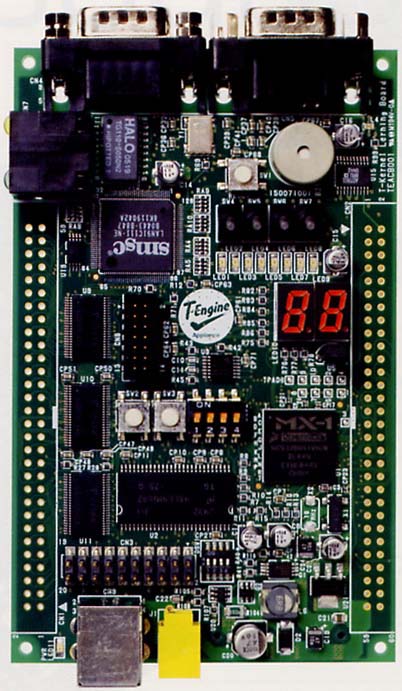 |
|
|
Teaboard, as we will explain below, has many features, but the biggest selling point is its cheap price. For tax included 47,250 yen (base price 45,000 yen), on top of a 32-bit CPU and the T-Kernel real-time operating system, one can get one's hands on a CPU board loaded with everything up to basic middleware for development, such as file management functions, and device drivers. As for development evaluation CPU boards that run T-Kernel, many types of T-Engine development kits and µT-Engine development kits have already been put on the market, but their median price range has been around 200,000 yen. This price of 200,000 yen is by no means high as the set price for a development evaluation board loaded with a 32-bit CPU plus a real-time operating system and various types of middleware plus a development environment. Actually, T-Engine development kits are widely utilized as development platforms for various T-Engine-based application products. However, on the other hand, there have been voices saying they want a delivery board on which T-Kernel runs at a cheaper price. Moreover, we have also received inquiries from many technical educational organizations asking if there aren't teaching materials that can be put together at a cheap price, since they would like to begin practicing T-Kernel programming and training. T-Engine development kits functionally can also be used for either of these uses, but in actuality there were also cases in which price served as a barrier. No matter how good the thing, the fact that it won't readily be used by people if it cannot be purchased at a cost corresponding to the objective of use is reality. Accordingly, Teaboard is what was developed after taking into account the desire to eliminate the price barrier so that we could have people in more settings use T-Kernel.
Cheapness is a good thing, but thinking it's probably bad because it's cheap is problematic. On that point, even for people who are planning to carry out various types of programming on top of T-Kernel or development evaluation of T-Engine base application products, Teaboard is made up into contents that can sufficiently answer those expectations.
|
|
|
| Target Side (Teaboard) Software | |
| T-Monitor | PMC T-Monitor |
| T-Kernel | PMC T-Kernel (MMU-compatible version) |
| T-Kernel Extension | PMC T-Kernel Extension (Process Manager, File Manager, etc.) |
| Middleware | TCP/IP |
| Device drivers | SD card, RS-232C, LAN, etc. |
| CLI | Command Line Interpreter (file operations, batch processing, etc.) |
| Tools | SD card partition creator, formatter, etc. |
| Host Side (Windows) Development Environment | |
| Compiler | GNU C/C++ compiler (Made compatible with T-Kernel) |
| Debugger | GDB (source level debugger) |
| Libraries | ANSI C library, T-Kernel-related libraries, etc. |
| Attached Documents | |
| Manuals | T-Kernel Specification, library manuals, development environment manual, etc. |
| Teaching materials | Various sample programs, text materials |
As for Teaboard target (the Teaboard actual hardware) side software, T-Monitor and T-Kernel, it goes without saying, and up to T-Kernel Extension, which provides process management functions and file management functions, are attached. Moreover, even device drivers, such as SD card, RS-232C, and LAN, are attached as standard equipment. On the development environment of the host (Windows) side, a compiler, a debugger, and libraries are included. These are exactly the same as the software configuration of the T-Engine development kits. Of course, various types of documentation needed in the development of hardware and software are also attached (Table 1). If you take it that there is no difference in the software of Teaboard and the T-Engine development kits, that's right, the secret of Teaboard's cheapness lies in its hardware. In concrete terms, we made it our policy not get caught up in the Standard T-Engine and µT-Engine hardware specifications, and to reduce the parts number by making use of as far as possible the peripheral I/O control functions built into the CPU chip (Freescale i.MX1). As a result, the number of parts on the circuit board decreased, and we were able to also hold down the manufacturing cost of the circuit board itself. Due to these circumstances, USB host [Note 1] and PCMCIA card functions are not supported on Teaboard. Moreover, the amount of RAM and Flash ROM also are somewhat less in comparison to the T-Engine development kits, and such things as the eTRON chip interface, LCD panel interface [Note 1] and the T-Engine expansion connector have been omitted (Table 2). I show in Table 3 a comparison of Teaboard and the T-Engine/ARM920-MX1 development kit, which is loaded with the same CPU.
|
|
|
| CPU | Freescale MC9328MX1 (i.MX1, ARM920T core, 200 MHz) |
| Flash ROM | 2 megabytes |
| RAM | 16 megabytes |
| SD card socket | 1 slot |
| RS-232C | D-sub, 9-pin, 2 channels |
| LAN | 10/100 Base-T |
| Generic switch | Push switch 2-bit, toggle switch 4-bit, DIP switch 4-bit |
| 7-segment LED | 2 figures |
| LED | 8-bit |
| Buzzer | Piezoelectric |
| Temperature sensor | -30° C ~ +100° C |
| I/O connectors | D/A and A/D convertors, GPIO (DIO), PWM |
| Expansion connector | Local bus |
|
|
||
| Teaboard/ARM920-MX1 | T-Engine/ARM920-MX1 | |
| Type | T-Engine Appliance | Standard T-Engine |
| CPU |
|
|
| Flash ROM | 2 megabytes | 16 megabytes |
| SDRAM | 16 megabytes | 64 megabytes |
| USB host | None (possible with expansion board) | Equipped (CYPRESS SL811HST) |
| USB function | Equipped (built into CPU): console use | None |
| PCMCIA | None | Equipped (RICOH RF5C296) |
| Serial RS-232C | 2 (build into CPU) | 1 (built into CPU): console use |
| Ethernet | Equipped (SMSC LAN91C111) | None (possible with an expansion board or PCMCIA card) |
| eTRON chip I/F | None | Equipped (built into CPU) |
| Audio input/output | None (possible with an expansion board) | Equipped (built into CPU) |
| Expansion bus I/F | Possible to install a general-purpose 60-pin connector | 140-pin connector for T-Engine use attached |
| RTC | Equipped (built into CPU) | Equipped (built into CPU) |
| LCD I/F Touch Panel I/F | None (possible with expansion board) | Equipped (built into CPU) |
| Other I/O | 7-segment LED, GPIC, PWM, temperature sensor, LED, switches, etc. | - |
| Power supply | USB power or AC adapter (separate) | AC adapter (attached) |
| Board external dimensions |
|
|
| ICE connection I/F | JTAG connector attached | Debugging board needed |
| T-Monitor | Attached | Attached |
| T-Kernel | Attached | Attached |
| T-Kernel Extension | Attached | Attached |
| Device drivers | Attached (excludes some devices) | Attached (excludes some devices) |
| TCP/IP | Attached | Sold separately (PMC T-Shell Development Kit) |
| Development environment |
|
|
On the other hand, several convenient functions that are not included in the T-Engine development kits have been added to Teaboard. Among these, the most useful one is the LAN function [Note 2], which demonstrates its power in the development of programs that use networks. In addition, we have equipped it with a large number of interfaces that are convenient in machinery control and programming practice. Moreover, we have loaded an SD card socket onto Teaboard, and thus it is possible to load such things programs under development and data in the file system on the SD card that has been inserted there. In the case of the T-Engine development kits, the method of use in which we place programs under development on the CF card inserted in the PCMCIA socket is typical; that which realizes a function in place of that is the SD card socket.
For these reasons, as concerns the Teaboard hardware, it is not based on the T-Engine specification, and thus Teaboard gets the handling of a T-Engine application product (a T-Engine appliance).
That we have standardized the hardware specifications of Standard T-Engine and µT-Engine in the T-Engine Forum is mainly something that takes into consideration the merits to users who develop hardware, such as expansion boards. To users who develop software on top of T-Kernel, the fact that the hardware specification is not T-Engine based will not become a problem whatsoever. Moreover, as for the hardware, rebuilding it to match it to the final product the user is developing is the norm. On the other hand, as for software beginning with T-Kernel and T-Monitor, even if a little customization is carried out, not much will be changed in the development platform and the final manufactured product. What reflects this actual state of affairs nicely, and has aptly responded even to the demands for lower cost, is the Teaboard product concept. As a low cost board that can be used even for T-Engine software programming practice, Teaboard could be called one example in which T-Engine hardware has been customized.
Teaboard is not just low cost. As we will explain below, it has many merits.
Friendly Even to T-Engine Beginners
Up to here, we have talked about Teaboard being gentle to one's purse when purchasing it. On top of that, Teaboard has been made into a product that is also friendly to beginners in the sense that even those doing T-Engine-based development for the first time can rest easy and come to grips with programming practice. Because self-study text materials and a large number of sample programs are attached, one can go on to acquire the know-how of how to use T-Kernel and T-Kernel Extension smoothly while reading through these (Fig. 2).
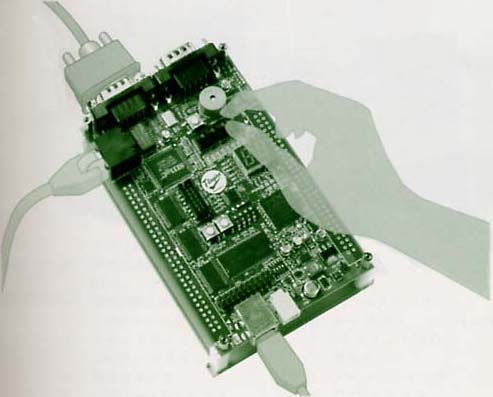 |
|
|
No Selecting a Spot for Development
As previously mentioned, due to differences in the devices that are loaded onto it, Teaboard is not based on the T-Engine specification, but the size of the board is the same as Standard T-Engine specification, being the compact size of roughly a postcard at 75 mm x 120 mm [TN]. Moreover, between the personal computer that serves as the development host and Teaboard, we connect a single USB cable that is used for the combined functions of data communication and supplying electricity. Accordingly, if you use a notebook personal computer as the host, you can get along with setting it up in a small amount of space, and if you make the personal computer battery powered, an AC power supply is not needed. Even the dream (?) of debugging on the Shinkansen, a concept mentioned several times from the time the T-Engine development kits went on sale, can be realized even more easily (Fig. 3).
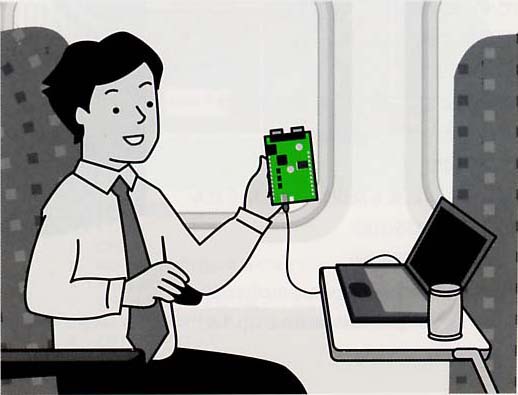 |
|
|
Various Inputs and Outputs Can Be Utilized
While it's a compact-size CPU board, as previously mentioned, Teaboard is loaded with various functions suitable for machine control and programming practice. As for software, besides Flash ROM, it is also possible to store it on an SD card. For communications, outside of one LAN port, we have equipped it with two serial ports (RS-232C). In the case of the T-Engine development kits, because the serial port, of which there is only one as standard equipment, is utilized as the console for development and debugging use, a serial port that could freely be utilized from the customer's applications was apt to be lacking. However, in the case of Teaboard, because a console for debugging use can be connected via the USB, either of the two serial ports can be freely utilized from an application. In addition to this, we have loaded onto Teaboard various input and output functions, such as general-purpose switches, a 7-segment LED, an ordinary LED (8-bit), a piezoelectric buzzer, and a temperature sensor. From fun programming practice in which these input and output functions are put to use and on up to high-level development evaluation business tasks that make use of networks, applications of Teaboard will expand limitlessly (Fig. 4).
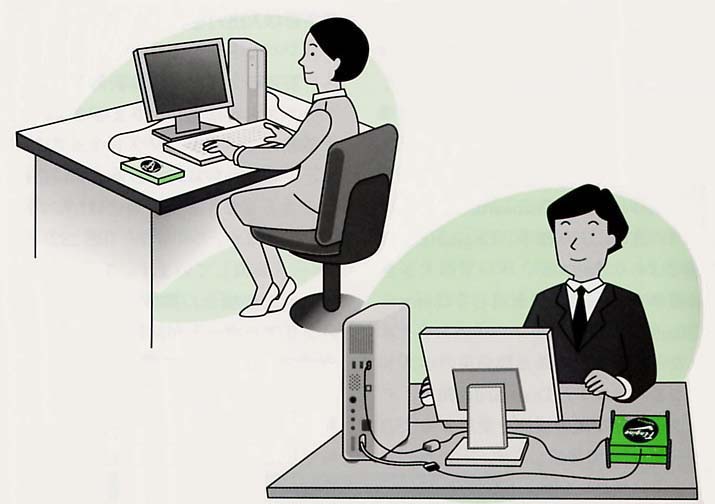 |
|
|
There's Augmentability
So that the user himself can easily connect hardware he has developed, Teaboard is made up so that the user can mount an expansion connector that connects to the CPU's local bus or an I/O connector [Note 3]. Through this I/O connector, such things as a GPIO port, through which various input and output controls based on settings will become possible; PWM output; and AD and DA converters can be utilized.
Furthermore, we are planning to put on sale an expansion board (option) that can connect to the above mentioned expansion connector. By means of the expansion board, it will become possible to also utilize a T-Engine LCD board and GUI functions of PMC T-Shell, and the like (Fig. 5).
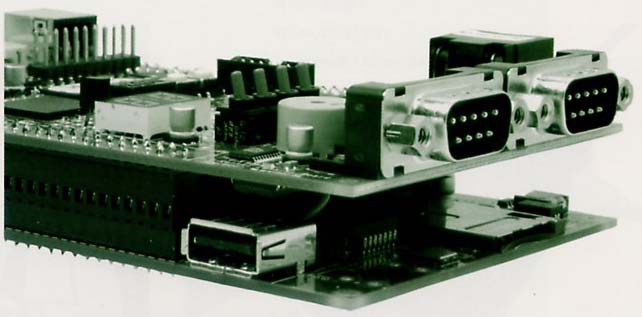 |
|
|
Customizing is Possible
Teaboard is not limited to programming practice and educational purposes, rather it is also possible to utilize it as a low cost embedded control board computer that runs T-Kernel. Moreover, based on the number being introduced, hardware and software customization and tuning matched to the customer's utilization objectives and operating environment are possible. For details, please make an inquiry to Personal Media.
Teaboard is scheduled to go on sale not just domestically in Japan, but also overseas from our company for use in the education of embedded system technicians. Accordingly, one could say that role Teaboard will shoulder also for the purpose of popularizing T-Kernel and T-Engine products internationally will be extremely great.
In this article, we have introduced the circumstances of Teaboard's appearance and its merits. This special feature will continue from a detailed explanation of each part of Teaboard to the introduction of application examples. We would be happy if this special feature serves as an aid in your introduction of Teaboard. On this opportunity, by all means please do a study on the utilization of Teaboard.
For Inquiries about Teaboard
____________________
[Note 1] Among the Teaboard expansion boards planned for sale in the future, a USB host and LCD panel interface, and an eTRON chip interface are scheduled to be loaded.
[Note 2] To utilize a LAN on top of the T-Engine/ARM920-MX1 development kit, it is necessary to use in parallel a PCMCIA-type LAN card, which is an optional LAN expansion board. In addition, software such as "PMC T-Shell development kit" is also necessary separately for TCP/IP and LAN drivers.
[Note 3] The connector itself is not mounted on the Teaboard standard product that is now on sale. In a case where you will connect other hardware via an expansion connector or I/O connector, it is necessary for the customer to obtain the connector on his own and solder it to the Teaboard circuit board. The pattern number of the connector to use is PS-60PE-D4T1-B1E (JAE), which is a 2.54 mm pitch, 60-pin standard one.
[Translator's Note] In Japan, a standard size postcard is 100 mm x 148 mm, which means that Teaboard is considerably smaller than a postcard.
The above article on Teaboard appeared on pages 24-28 in Vol. 95 of TRONWARE. It was translated and loaded onto this Web page with the permission of Personal Media Corporation.
Copyright © 2005 Personal Media Corporation
Copyright © 2008 Sakamura Laboratory, University Museum, University of Tokyo